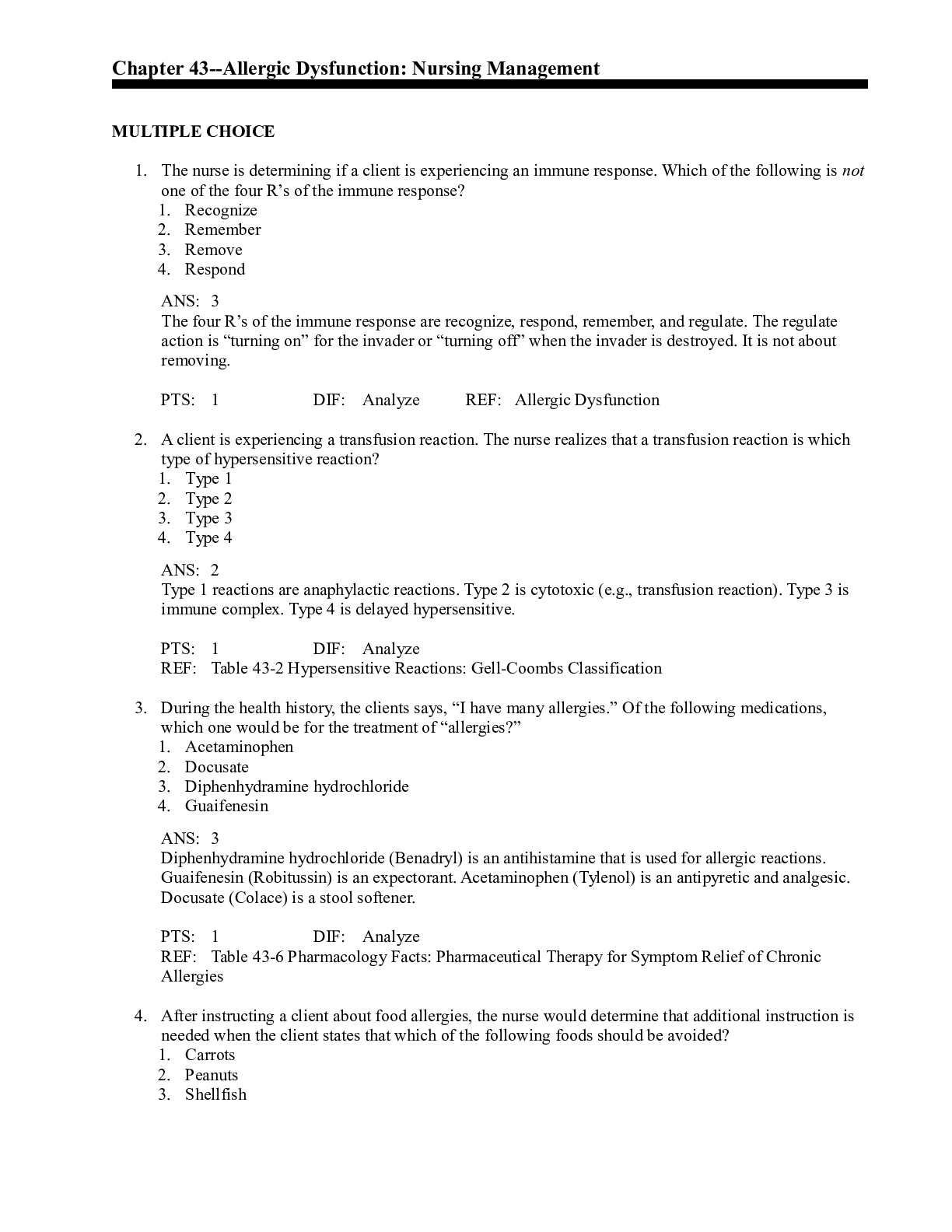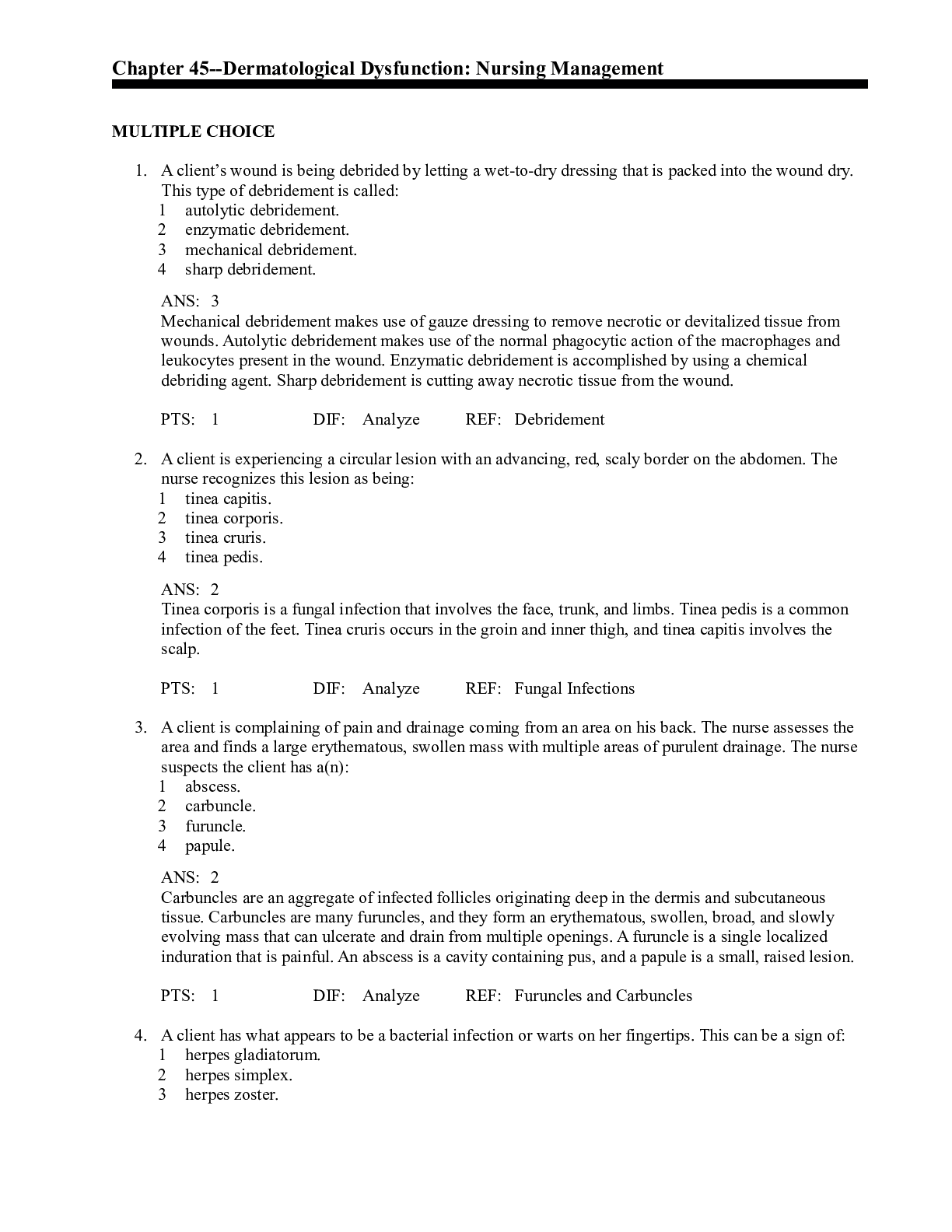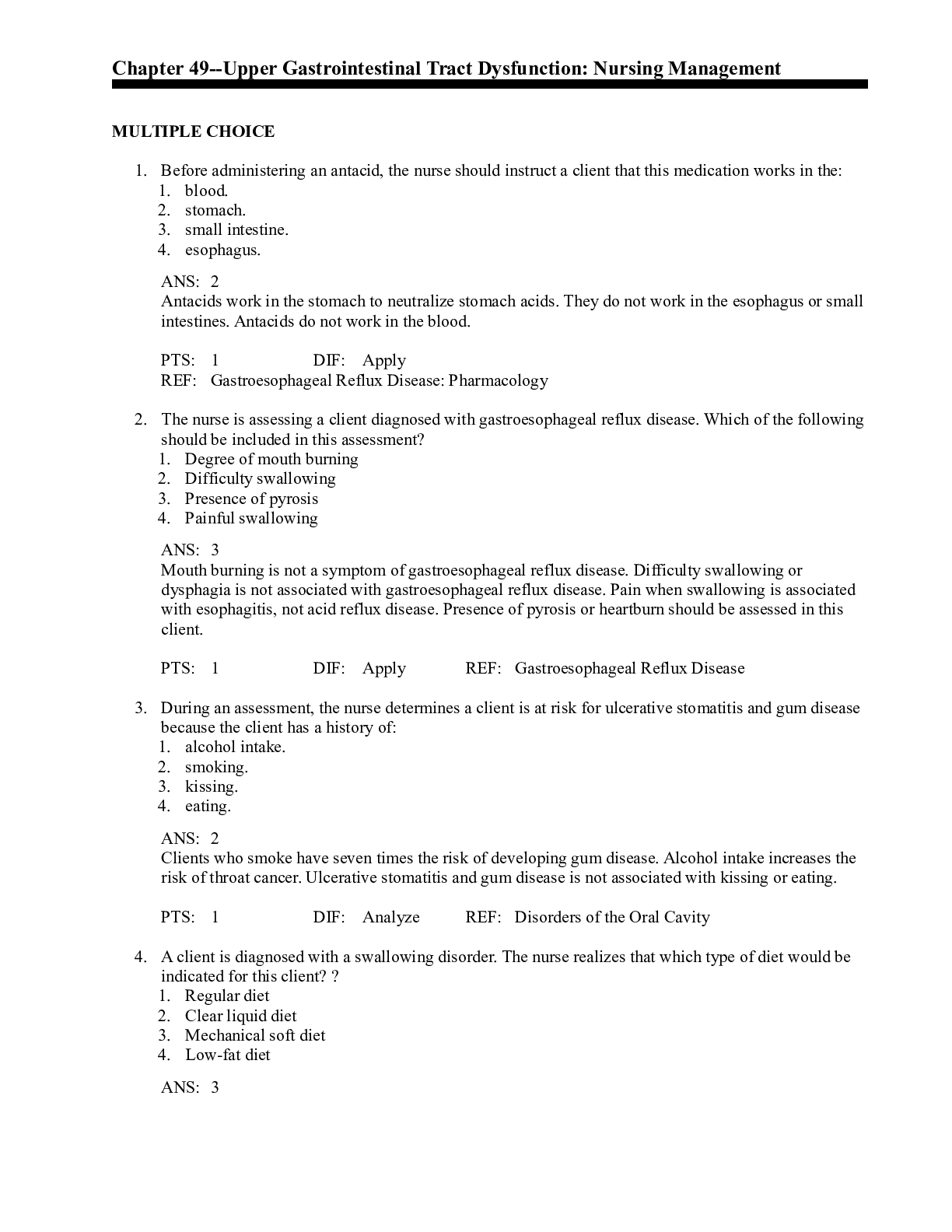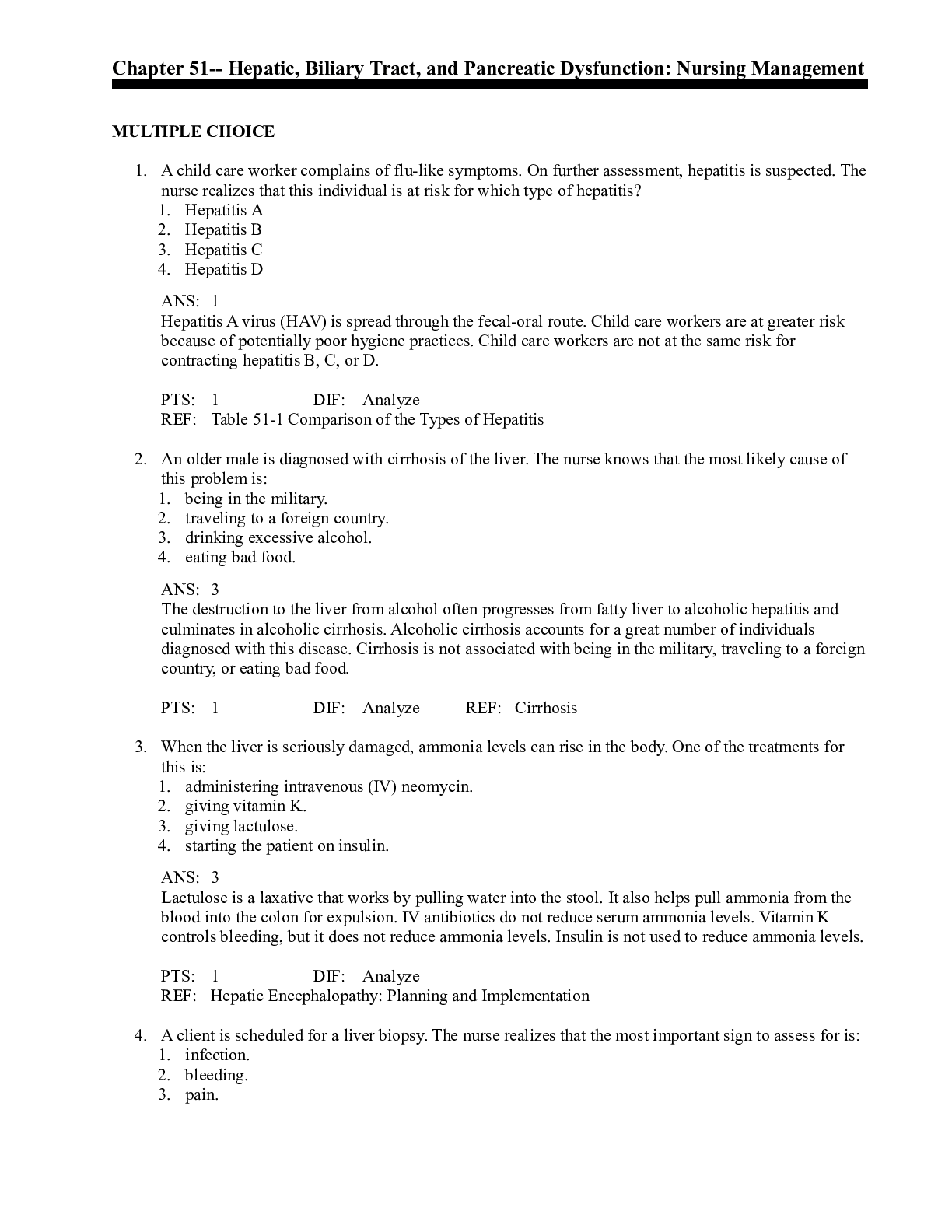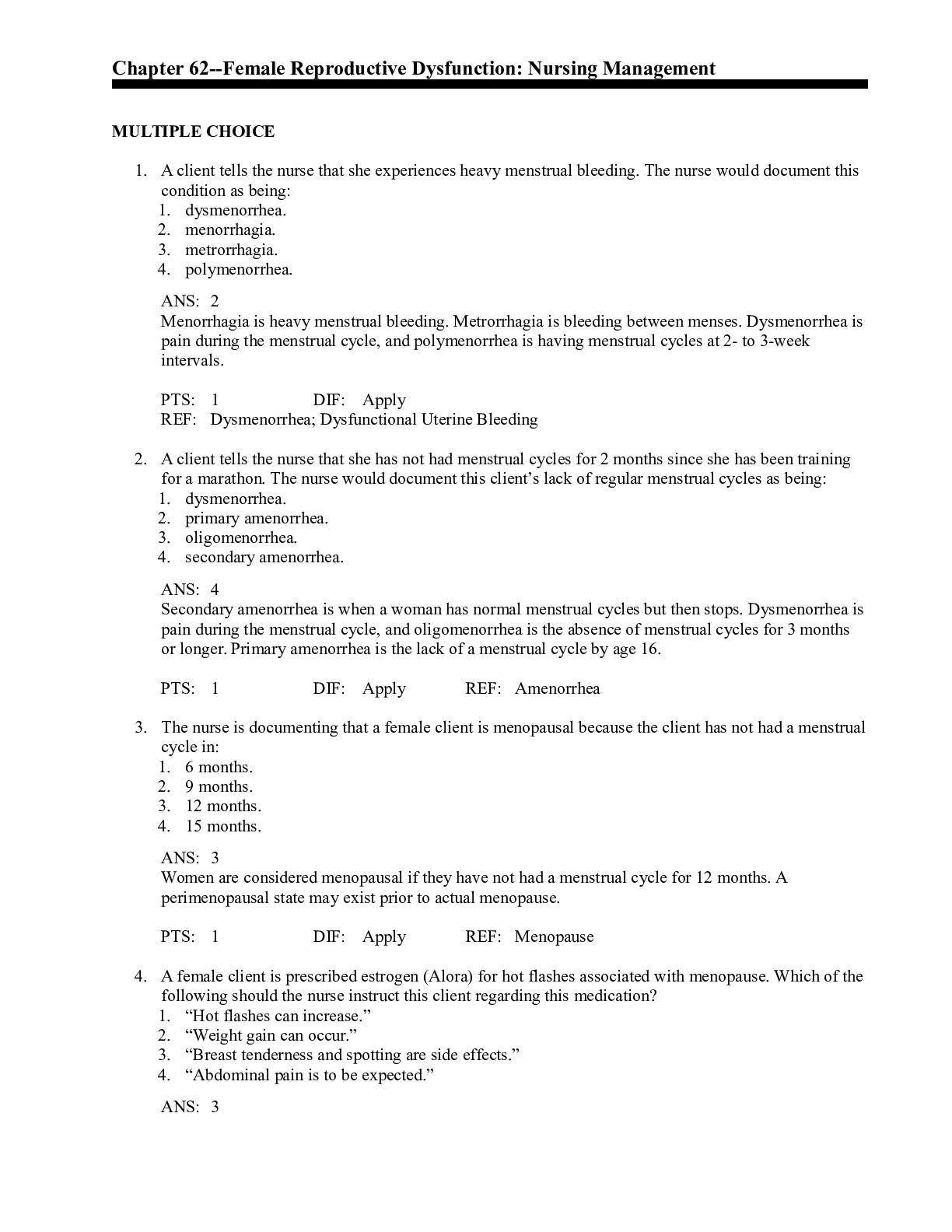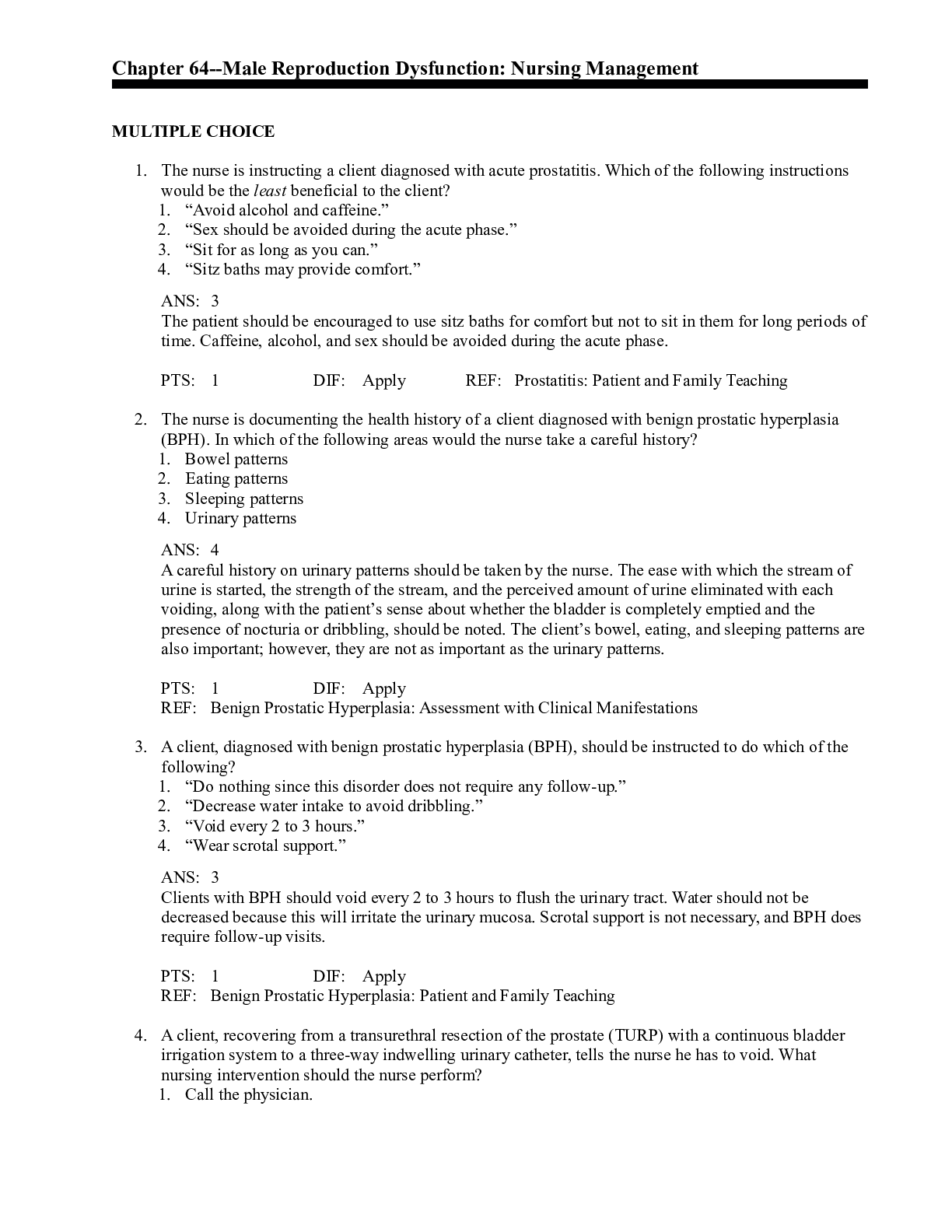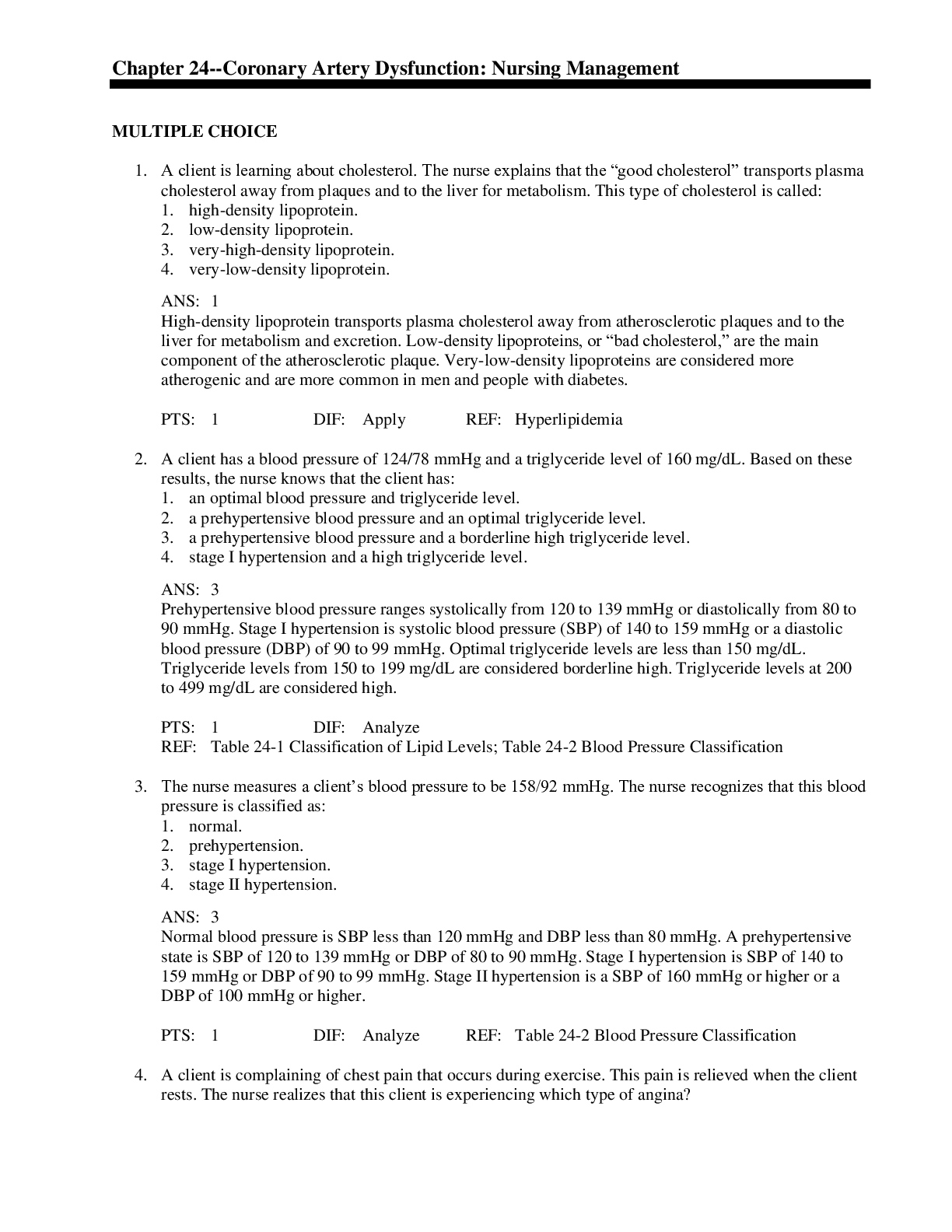*NURSING > QUESTIONS & ANSWERS > Chapter 53--Urinary Dysfunction: Nursing Management (All)
Chapter 53--Urinary Dysfunction: Nursing Management
Document Content and Description Below
Chapter 53--Urinary Dysfunction: Nursing Management MULTIPLE CHOICE 1. A client is being evaluated for a lower urinary tract infection. Which of the following symptoms would the nurse expect to fin... d? 1. Cloudy urine 2. Flank pain 3. Nausea 4. Temperature 102.9°F = PTS: 1 DIF: Apply REF: Urinary Tract Infection: Assessment with Clinical Manifestations 2. An elderly client is diagnosed with a urinary tract infection. Which of the following will the nurse most likely assess in this client? 1. Jaundice 2. Vomiting 3. Poor eating habits 4. Change in mental status = PTS: 1 DIF: Apply REF: Urinary Tract Infection: Assessment with Clinical Manifestations 3. A nurse is collecting a post-void residual urine volume for a client. Which of the following volumes would be abnormal? 1. 30 mL 2. 60 mL 3. 95 mL 4. 125 mL =PTS: 1 DIF: Apply REF: Box 53-1 Summary of Diagnostic Tests for UTI 4. A client is prescribed trimethoprim-sulfamethoxazole for a urinary tract infection. Which of the following instructions would not be appropriate for this medication? 1. Complete all the medication even if you feel better. 2. Drink extra water during the day. 3. Take on an empty stomach with water. 4. Take with an antacid. =PTS: 1 DIF: Apply REF: Box 53-2 Common Medications Used with Patients with UTI 5. A client with a urinary tract infection is being discharged with a prescription for ciprofloxacin. The nurse should include which of the following discharge instructions? 1. “Do not take within 2 hours of antacid use.” 2. “Limit fluids.” 3. “Restrict activity” 4. “Expect to be nauseated with this medication.” PTS: 1 DIF: Apply REF: Box 53-2 Common Medications Used with Patients with UTI 6. A client is recovering from a cystoscopy. The nurse would expect to assess which of the following regarding the client’s urine after the procedure? 1. Anuria 2. Blood clots 3. Hematuria 4. Pink-tinged PTS: 1 DIF: Analyze REF: Urinary Tract Infection: Diagnostic Tests 7. A client is being treated for interstitial cystitis. Which of the following medications would not be prescribed for this client? 1. Cortisone acetate (Cortone) 2. Dimethyl sulfoxide (DMSO) 3. Pimecrolimus (Elidel) 4. Polysulfate sodium (Elmiron) PTS: 1 DIF: Analyze REF: Box 53-4 Common Medications Used with Patients with IC 8. After being diagnosed, a client asks the nurse “What is pyelonephritis?” The nurse should respond: 1. “Pyelonephritis is an infection of the bladder.” 2. “Pyelonephritis is an infection of the urethra.” 3. “Pyelonephritis is an infection of the prostate.” 4. “Pyelonephritis is a common infection that needs to be treated to prevent complications.” PTS: 1 DIF: Apply REF: Pyelonephritis: Pathophysiology 9. The nurse is reviewing the health history of a client diagnosed with glomerulonephritis. Which of the medical conditions would be a risk factor for developing glomerulonephritis? 1. Asthma 2. Hypertension 3. Recent “strep throat” 4. Renal failure PTS: 1 DIF: Analyze REF: Glomerulonephritis: Etiology 10. The nurse is assessing a client diagnosed with glomerulonephritis. Which of the following findings is consistent with this disorder? 1. Brown urine 2. Hip pain 3. Hypotension 4. Bradycardia PTS: 1 DIF: Apply REF: Glomerulonephritis: Assessment with Clinical Manifestations 11. A client is diagnosed with nephrotic syndrome. Which of the following is the nurse most likely going to assess in this client? 1. Glucosuria 2. Proteinuria 3. Hematuria 4. Oliguria PTS: 1 DIF: Apply REF: Nephrotic Syndrome: Assessment with Clinical Manifestations 12. A client is surprised to learn that his acute pain is caused by a kidney stone. The nurse should instruct the client that the most common type of renal calculi is composed of: 1. calcium. 2. cystine. 3. struvite. 4. uric acid. PTS: 1 DIF: Apply REF: Urinary Tract Calculi (Urolithiasis): Pathophysiology 13. A client is hospitalized with kidney trauma resulting in lacerations to the parenchyma. Which of the following would be included in the management of this client’s care? 1. Bed rest with antibiotic therapy 2. Restrict fluids 3. Encourage early ambulation 4. Nephrectomy PTS: 1 DIF: Analyze REF: Renal System Trauma: Planning and Implementation 14. The nurse is reviewing a client’s risk factors for the development of renal cancer. Which of the following would be considered a risk factor for the development of this disease? 1. Cigarette smoking 2. Being underweight 3. History of hypotension 4. History of type 2 diabetes mellitus PTS: 1 DIF: Analyze REF: Box 53-7 Causes for Renal Cancer 15. A client is scheduled for surgery to remove the bladder and create a urinary diversion. If the client has a history of complications after surgery, the type of urinary diversion that might be indicated would be: 1. continent diversion with a surgical opening to the abdomen. 2. continent diversion with a replacement bladder made out of intestine. 3. noncontinent diversion with anastomose of the ureters to the anterior wall. 4. noncontinent diversion with anastomose of the ureters to the rectum. PTS: 1 DIF: Analyze REF: Urinary Diversion: Surgery MULTIPLE RESPONSE 1. The nurse is instructing a client on ways to prevent urinary tract infections. Which of the following should be included in these instructions? (Select all that apply.) 1. Drink cranberry juice. 2. Drink eight glasses of water. 3. Take baths instead of showers. 4. Urinate before and after intercourse. 5. In women, wipe back to front after voiding. 6. Take the prescribed medication until the symptoms subside PTS: 1 DIF: Apply REF: Patient Playbook: Considerations for Patient Teaching 2. A client is diagnosed with an upper urinary tract infection. Which structures are affected by this infection? (Select all that apply.) 1. Bladder 2. Kidney 3. Prostate 4. Ureters 5. Urethra 6. Rectum PTS: 1 DIF: Apply REF: Urinary Tract Infection: Pathophysiology 3. The nurse is instructing a client on ways to reduce formation of future kidney stones. Which of the following should be included in these instructions? (Select all that apply.) 1. Drink plenty of fluids. 2. Drink soft drinks. 3. Limit the intake of spinach. 4. Take a vitamin B-12 supplement or eat foods rich in vitamin B-12. 5. Take a magnesium citrate supplement or eating foods rich in magnesium citrate. 6. Adjust calcium intake. PTS: 1 DIF: Apply REF: Patient Playbook: Self-Care Nutrition Advice 4. A client is diagnosed with renal vein thrombosis. The nurse realizes that which of the following could be indicated in this client’s plan of care? (Select all that apply.) 1. Corticosteroids 2. Nephrectomy 3. Anticoagulants 4. Antihypertensives 5. Surgical intervention 6. Antibiotics PTS: 1 DIF: Analyze REF: Table 53-6 Renal Vascular Disorders 5. The nurse is assessing a client for type of urinary incontinence. Which of the following are considered types of this disorder? (Select all that apply.) 1. Stress 2. Radical 3. Urge 4. Temporary 5. Overflow 6. Functional PTS: 1 DIF: Analyze REF: Box 53-9 Types of Incontinence [Show More]
Last updated: 1 year ago
Preview 1 out of 6 pages
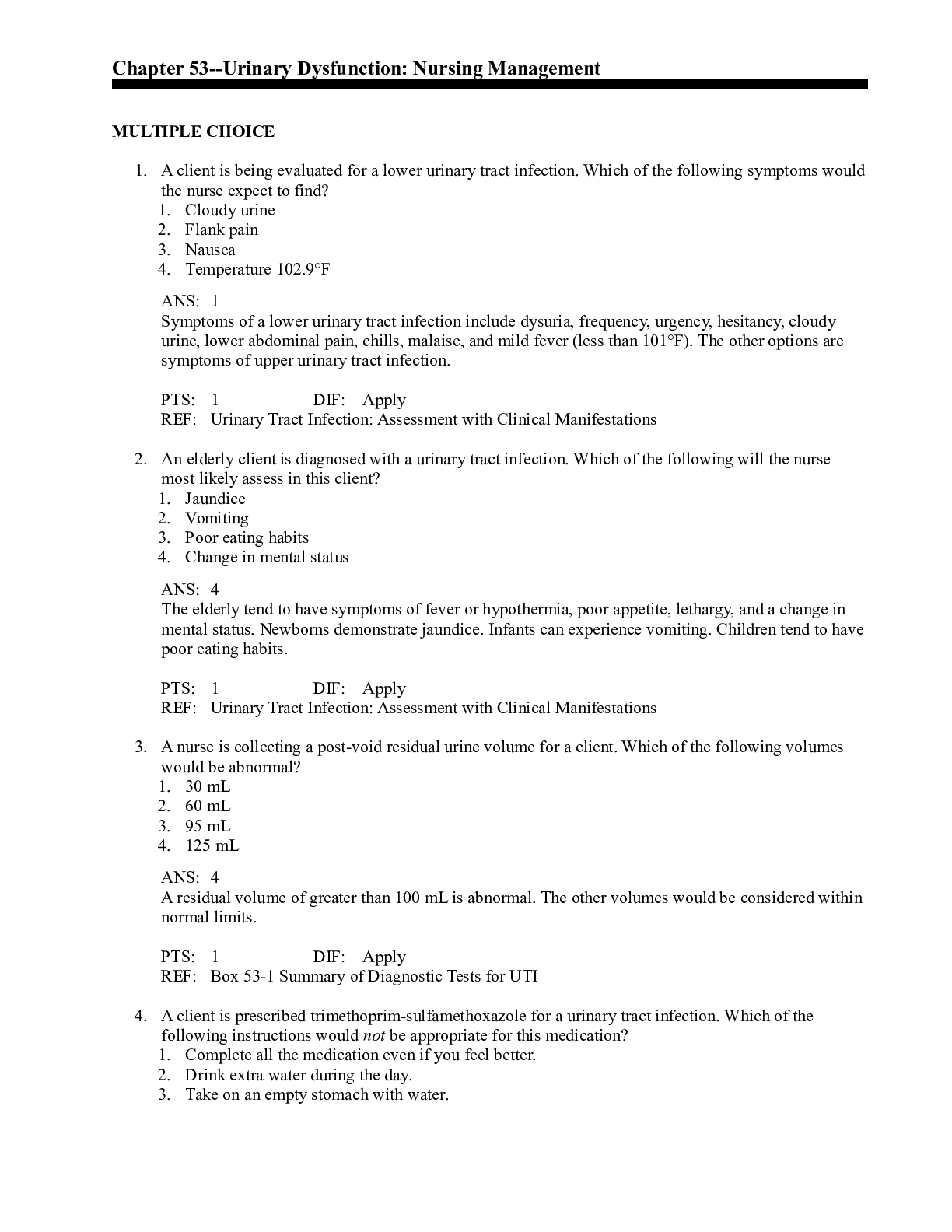
Buy this document to get the full access instantly
Instant Download Access after purchase
Add to cartInstant download
We Accept:

Reviews( 0 )
$5.00
Document information
Connected school, study & course
About the document
Uploaded On
Jan 20, 2020
Number of pages
6
Written in
Additional information
This document has been written for:
Uploaded
Jan 20, 2020
Downloads
0
Views
44













